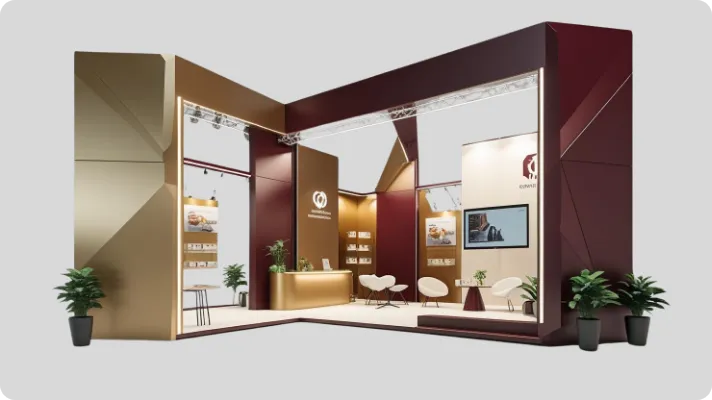
Exhibition booth design: the art of attracting attention and attracting customers
Did you know that by designing an exhibition stand in a principled and intelligent manner, you can attract all eyes among hundreds of stands? Building an exhibition stand using the principles of creative outdoor advertising quickly turns visitors into potential customers. In the process of building an exhibition stand, each stand uniquely represents the values and identity of a brand. Choosing the right materials, using targeted lighting, and intelligent space design are among the factors that help create an effective and attractive visitor experience.
With a deep understanding of your business goals, the Ideh Rahyab team creates an attractive and functional space that showcases your expertise and ensures your brand’s impact at major events.
Every business needs a roadmap to grow. We will clear the path to your success with analysis, ideation, and careful planning.
Why do we need a professional booth to attend exhibitions?
Attending exhibitions is a tool to showcase your brand and the investment you have made over the years. In the competitive exhibition environment, ordinary and repetitive booths easily get lost in the crowd. To stand out from your competitors and have a strong presence, you need a professional booth. The reasons for needing a professional booth among competitors are:
- At a busy trade show, your booth design is the first thing that catches visitors’ attention. With the help of an expert booth design team, you can create an attractive space that stands out from your competitors.
- Increase brand visibility: A professional booth with a proper visual design will strengthen your brand identity. The right use of colors, logo, and visual elements will make your brand memorable in the minds of visitors and ultimately help increase brand visibility at the event.
- Attracting media attention: Creative booths attract more attention from reporters and the media. Using creativity in design can increase the chances of your booth being seen at the exhibition.
- Cost savings: Although professional design may seem expensive at first, an experienced booth design team can prevent costly errors during construction and implementation. Also, a successful booth can result in a significant return on investment that justifies the initial costs.
- Marketing and Customer Engagement: Professional booths, with appropriate layout and space, provide an environment for displaying products, holding demos, and interacting directly with customers. This space helps you easily connect with your audience and convert them into customers.


- Main structure using chipboard
- Floor covering (reused parquet)
- Lighting (Halogen, Fluorescent, Projector)
- Sticker/Unolit text advertising
- Banner/Flex image advertising for every 10 meters, 1 meter of flex (lightbox)
- Information desk: 1 piece of chipboard for every 50 meters
- Vip furniture (black 4-seater set with coffee table for every 100 meters 1 set) Cip furniture for every 50 meters 1 set 3-seater black cip
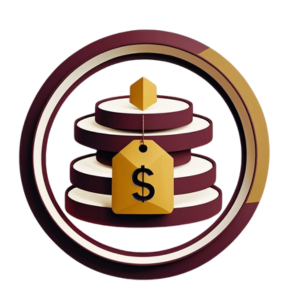
- Main structure using chipboard
- Floor covering (parquet used once)
- Led/Fluorescent/Projector/Fantasy Lighting
- Sticker text advertising per 10 meters of sticker
- Written advertising (plexiglass / chelnium) Plexiglass for every 50 meters 2 meters
- Information desk: 1 piece of locked chipboard for every 50 meters
- Vip furniture, 4-seater sofa set or 6-seater black conference set per 50 meters. Cip furniture, 1 set of 4 black or 3 white, Eiffel stand, water cooler + refrigerator + natural vase / stand, catalog
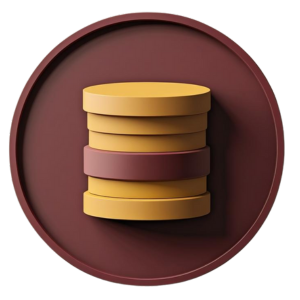
- Main structure using chipboard + raw MDF with paint coating
- Floor covering (parquet as new)
- Decorative / Dedicated / Led Lighting
- Sticker/Unolit text advertising without limits
- Plexiglass/Chelnium written advertising: 1 meter of chelnium and 1 meter of plexiglass for every 50 meters
- Information desk: 1 piece of locked chipboard for every 50 meters
- Vip furniture, white or black furniture in any quantity and conditions requested by the customer, Cip furniture for every 30 meters, 1 set of 4 black or 3 white seats, Eiffel stand, water cooler / refrigerator / internet / flower arrangement / natural / coffee maker / heater / fan / catalog stand, etc.



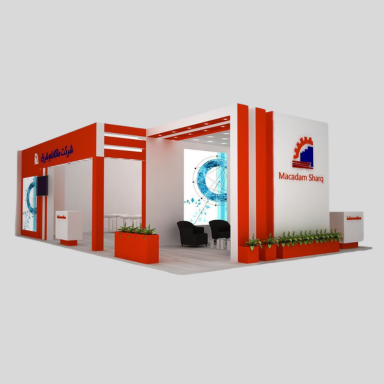
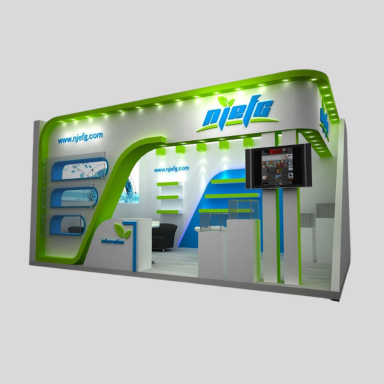
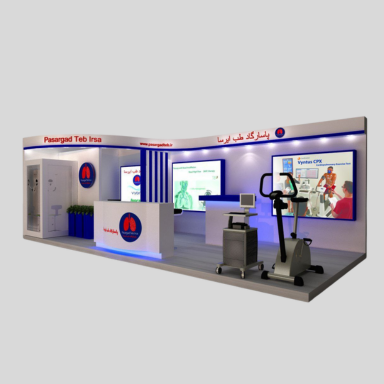


The final cost depends on factors such as the size of the booth, the materials used, and the complexity of the design. After an initial consultation and review of your needs, we can provide an accurate estimate of costs.
From final design approval to installation and commissioning of the booth at the exhibition site, it usually takes between two and four weeks. This timing depends on the size of the project and the implementation details.
A custom booth is designed entirely based on your brand identity and needs, and is unique. In contrast, a prefabricated booth uses ready-made components and structures and has less flexibility in design.
With an attractive and functional design, smart use of peripheral equipment (such as displays and stands), and a focus on direct interaction with visitors, you can significantly increase the efficiency of your booth.
The choice of material depends on your budget and design style. Common materials such as MDF, wood, metal, and glass each have a different visual impact and cost.
A professional booth construction team, using modern knowledge and creativity, will create a booth that stands out from the competition, increases your brand’s credibility, and ultimately attracts more visitors.
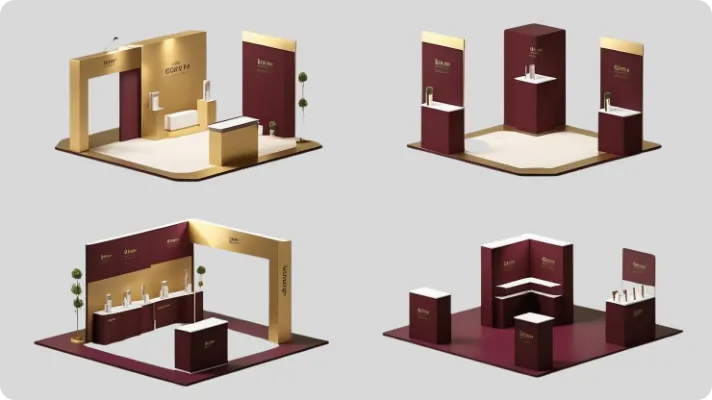
What are the types of exhibition stands? Choosing the right model for your business
Choosing the right booth type is the first step to a successful exhibition presence. Exhibition booth types are categorized according to their location and size in the exhibition space, and each has its own unique features and benefits. Understanding these differences will help you choose the most appropriate booth layout to showcase your brand.
Below, we will examine the four main types of exhibition booths:
In-line Booth
This type of booth, also called a linear booth, is located in a row between two other booths. A row booth has access to the aisle on only one side and shares the other two sides with adjacent booths. These booths are usually the most cost-effective option and are suitable for small and medium-sized businesses looking for an effective presence.
Corner Booth
A corner booth is located at the end of a row and has access to the aisle from two directions. This feature allows the booth to be viewed from two different angles, creating more opportunities to attract visitors. A corner booth is more expensive than a row booth, but it provides more visibility and traffic, making it a good option for businesses that want to be more visible.
Island Booth
An island booth is a freestanding booth that has aisle access from all four sides. These types of booths are located in the center of exhibition halls, providing the most visibility and flexibility in design. Island booths are usually suitable for large, well-known companies that need ample space to display products or conduct interactive activities with visitors.
Custom Booth
This type of booth is designed and built entirely specifically to suit the needs of a brand. A dedicated booth can be implemented in any of the above formats (corner, row or island), but it is unique in terms of design and implementation. Designing a dedicated booth allows companies to showcase a strong and distinctive identity of their brand by using creativity and special materials. The impact of dedicated booths is much greater.

Exhibition booth design stages from idea to implementation
Designing a professional exhibition booth is a meticulous and artistic process that starts with ideation and continues until the final execution. The Ideh Rahyab team is with you throughout all these stages, from needs analysis to booth installation and commissioning, helping you to stand out among your competitors at crowded exhibitions. Familiarity with these steps will help you choose the best booth for your exhibition with a broader perspective.
Needs analysis and preliminary design
The booth design process begins with a thorough understanding of your goals. At this stage, we listen carefully to your needs. Analyzing your business needs and goals helps us create a precise and targeted strategy. We seek answers to these questions:
- What is your main goal in attending the exhibition?
- Who is your target audience?
- What is your budget and schedule like?
Design and approval of the final design
After the initial planning, it’s time to create an idea that will bring you closer to your goals. This stage involves a creative and technical process:
- Conceptual design and initial sketch: First, creative ideas are formed into manual or digital designs based on the identified needs and strategy.
- 3D Booth Design (CAD, 3D): Initial ideas are transformed into 3D models. With these advanced models, you can view your booth virtually and from different angles before any construction.
- Design Approval and Changes: After providing feedback and implementing your comments and changes, the final design reaches the final approval stage.
Booth construction and implementation
After the final approval of the plan by the employer, we enter the operational phase, which requires precision and supervision.
- Selection of construction materials: Based on the approved design and your budget, the highest quality raw materials are selected. This stage includes selecting wood, metal, glass, and the materials needed to build the various components of the booth.
- Booth production and construction: The construction of booth parts is carried out in well-equipped workshops under the close supervision of the technical team.
- Booth Installation and Setup: At the exhibition site, the booth is installed accurately and on time and is ready for use. Our executive team will create the booth in the best possible way, while adhering to safety standards.
- Final Review and Evaluation: Before the exhibition opens, a final review and evaluation will be conducted by you and our team to ensure quality, lighting, layout and full compliance with the original design. Our goal is to ensure that your booth is flawless in every way and ready to attract attention.

What is the process of choosing the right design for exhibition stands?
A successful exhibition stand is the result of careful planning, understanding the audience, and professional execution. The more careful you are in the design and layout selection stage, the more productive your exhibition presence will be. Building an exhibition stand in a systematic manner will turn visitors into customers. To achieve this goal, it is best to follow the following steps:
1. Specify the purpose of attending the exhibition
Before deciding on a booth design, you need to know why you are attending the trade show. Objectives can include:
- Introducing a new product or service
- Increase brand awareness among audiences
- Attracting sales representatives or investors
- Direct sales on site
Once the goals are clear, the booth layout is designed exactly along the same lines. For example, a booth that aims to sell should have product display space and a transaction section. While a booth with branding goals needs more attention to visual effects and user experience.
2. Identifying the target audience
Understanding your audience is one of the most important principles of booth design. By analyzing customer personas, you can create a design that most closely matches the tastes and needs of visitors.
For example:
- If the audience is young and dynamic: using vibrant colors, modern design, and creative lighting is recommended.
- If the audience is formal and industrial: a minimalist style, corporate colors, and a professional atmosphere are more effective.
3. Choosing the type of exhibition booth
The type of booth should be chosen according to your size, location, budget, and goals:
- In-line: For simple exhibition presence
- Corner: Allows the booth to be seen from two sides and increases attention
- Island: Full display from all directions and high flexibility
- Custom: Personalized design for differentiation and branding
4. Design based on the visitor’s movement path
The design of an exhibition booth should be such that upon entry, the visitor follows a clear and fluid path and interacts with all parts of the booth.
The basic layout of product displays, the reception area, the conversation space, and even the exit route should all be intelligently designed to avoid crowding or confusion.
5. Paying attention to visual elements and branding
It is especially important to coordinate colors, logos, fonts, and images with brand guidelines. Visual effects in exhibition stands make the audience more inclined to stop, examine the details, and connect with the brand after seeing the stand.
Also use:
- Creative lighting
- Quality material
- Advertising displays and videos
It can make your booth a point of distinction at the exhibition.
6. Review budget and schedule
A professional design should be feasible within your budget and time constraints. Managing costs and having a precise schedule for the design, construction, and installation stages of your booth is essential. This ensures that your booth is ready for use on time.
7. Final review before implementation
Before you start building, be sure to use a 3D render. This digital model allows you to:
- Fix any potential issues.
- Check the coordination of colors and materials.
- Get a real preview of the final booth
If you want to have a distinctive and impressive booth, you can use the booth design and implementation services of Ideh Rahyab Experts. Our team, with extensive experience in domestic and international exhibitions, is ready to implement the best design in accordance with your goals.
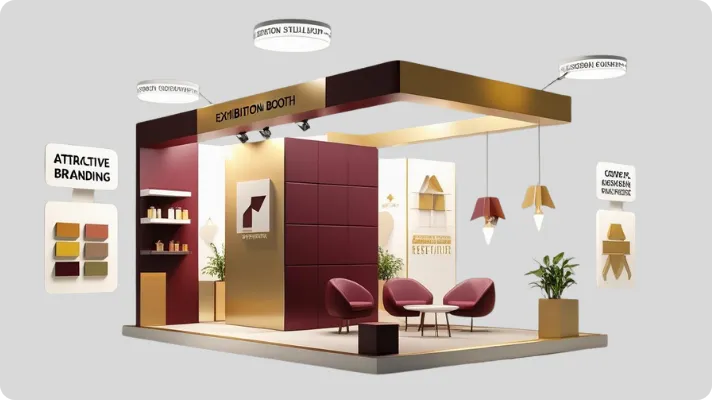
What are the important points in building an exhibition stand?
To build a professional exhibition booth, you need to pay attention to the details and important points. These points are more important than the appearance. Therefore, in the process of building the booth, pay attention to the points that we will mention below. First, the design should be in perfect harmony with your brand identity. So that it attracts the attention of the audience by using smart color and lighting choices, appropriate graphic design, and attractive advertising signs and banners. Next, it is important to focus on the user experience (UX) of the booth; meaning that the layout and furniture of the booth should provide a comfortable and functional space for communicating with your business. Finally, observing implementation points such as using high-quality materials, speed of booth installation, and also viewing the prototype of the booth before installation, will ensure that your booth will not only be beautiful, but also efficient and flawless in practice.
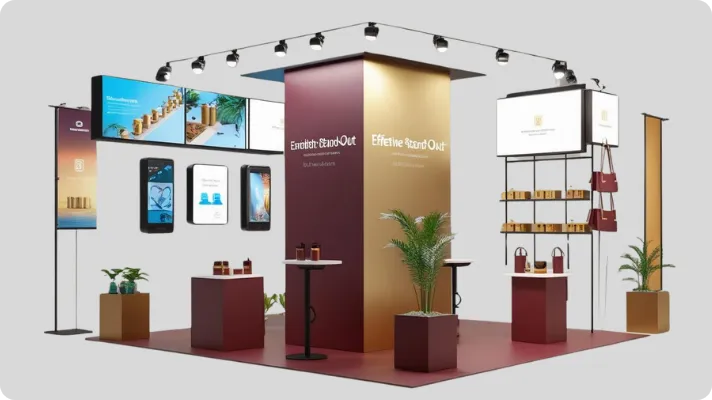
How to differentiate our presence at the exhibition with booth accessories?
After the basic design and structure of the booth, the accessories give it life. The appropriate use of these accessories will transform your booth from a static space into a dynamic and attractive environment that will attract visitors to stay and interact more.
- Audio-visual equipment: Today, large screens and video walls have become a practical tool for attracting attention. Using audio-visual equipment such as LCD or LED TVs, you can display promotional videos, product demos, or infographics. Also, a suitable sound system with soft music or brand-related sounds can create a pleasant atmosphere.
- Advertising stands: Advertising stands such as roll-ups, pop-ups and catalog stands are cost-effective tools for the booth. These stands, which are easily portable and set up, provide important information to visitors and help them become familiar with your products or services even before entering the booth. Using graphic design in these stands increases their impact.
- Tables and Chairs: Placing tables and chairs in your booth creates a friendly and comfortable space for business conversations and negotiations with customers. This furniture sends the message to visitors that you value their interaction. A small reception table at the entrance of the booth or a few chairs can provide valuable opportunities for connecting with customers.
- Ventilation and lighting systems: These systems play an important role in the comfort of your booth. A professional lighting system can direct the visitor’s attention by highlighting important parts of the booth. Also, an air conditioning system, especially on busy days of the exhibition, creates a pleasant environment for your team and visitors and helps them feel more relaxed in your booth.

Budget and costs of booth design and construction in Idea Rahyab
In the booth construction process, budget is an important factor. At Idee Rahyab, we have made transparency in costs our main focus so that you can make the best decision for your exhibition investment with complete confidence. The final cost of an exhibition booth is affected by the following factors:
- Materials: The type of material used has a big impact on cost. Using simpler materials like chipboard and cheaper woods is associated with lower costs, while using more luxurious materials like patterned MDF, glass, metal, and advanced lighting increases the cost.
- Dimensions and Area: The size and dimensions of the booth are the main factors in determining the price. The larger your booth is and the more space it takes up, the higher the cost of building and implementing it will be.
- Design and details: The complexity of the design, the presence of special details, unique architectural elements, graphic design, and interactive features all play a role in determining the price. A simple design will cost differently than a complex 3D design.
At Idee Rahyab, we help you to have an optimal budget. Instead of providing a fixed price, we first hold meetings with you to analyze the needs and goals of the business. After that, considering your budget, we estimate the costs based on the needs and budget. This approach helps us to deliver a professional booth, of the highest quality, and within the specified budget. We believe that an optimal budget is a budget that is not only affordable, but also covers all your goals.

The impact of booth design on visitor attraction and sales
The success of a booth depends not only on its beauty, but also on how intelligently it is designed to communicate with visitors. Below, we will compare the impact of each of the main elements of booth design on the two ultimate goals of attracting visitors and increasing sales.
| Impact criterion | on visitor attraction | Impact on increasing sales |
| Visual appeal: | Creating a positive first impression and attracting people’s attention from a distance | .Forming a positive and professional mindset that encourages customers to buy. |
| Layout and movement path: | Easy visitor guidance in the booth and increase dwell time. | Creating a comfortable shopping experience and complete introduction of products or services. |
| Brand identity: | Quick brand recognition and differentiation from competitors. | Creating a sense of trust and brand recall after the exhibition. |
| Interactive sections: | Attract people to directly experience products or services. Increase the likelihood of making a | purchase decision due to hands-on experience. |
| Comfort and amenities create | a pleasant feeling and encourage longer stays | .More opportunities for conversation and making sales proposals. |
| Showcase products | and servicesQuickly and clearly introduce what the brand offers Focus on | sales-driven features and competitive advantages |
Getting advice can get you off to a better start!
10% discount for all new customers!
